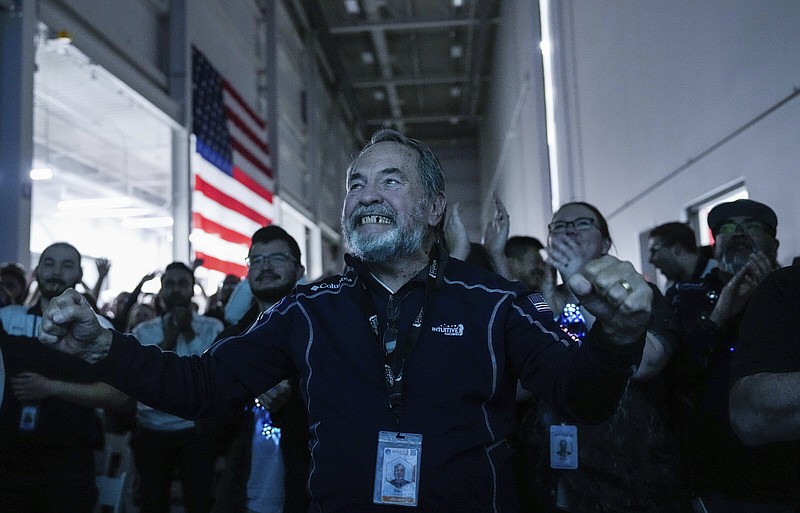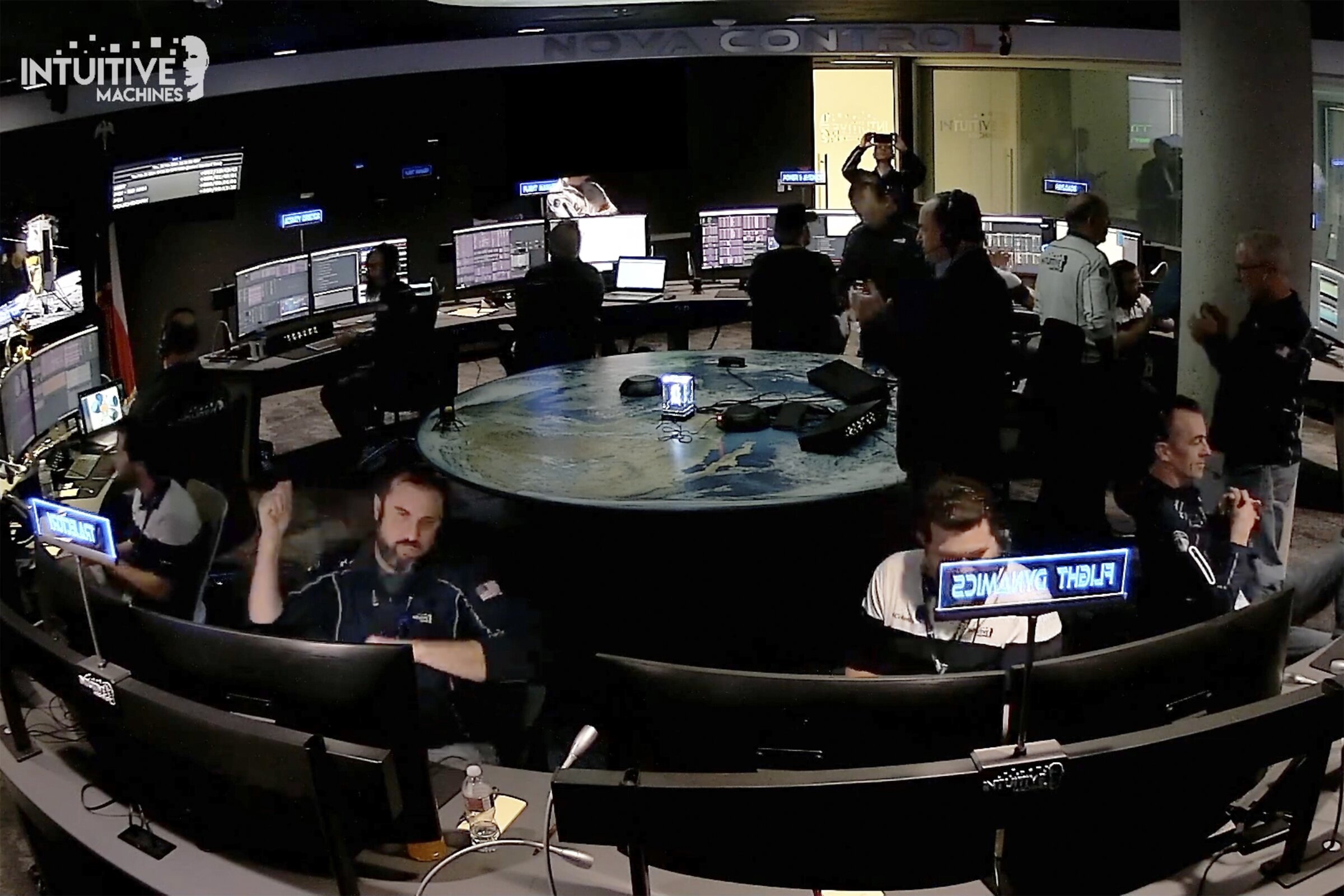CAPE CANAVERAL, Fla. -- A private lander on Thursday made the first U.S. touchdown on the moon in more than 50 years, but managed just a weak signal back until flight controllers scrambled to gain better contact.
It is the first American spacecraft on the moon since Apollo 17 in 1972, the closing chapter in humanity's astonishing achievement of sending people to the moon and bringing them all back alive.
Despite the spotty communication, Houston-based Intuitive Machines, the company that built and managed the craft, confirmed that it had landed upright. But it did not provide additional details, including whether the lander had reached its intended destination near the moon's south pole. The company ended its live webcast soon after identifying a lone, weak signal from the lander.
The landing time came and passed, but teams did not get instant communication again with the lander.
About 10 minutes after landing, Intuitive Machines' Mission Director Tim Crain said, "Signs of life. We have a return of signal we're tracking. ... We're not dead yet."
"We're picking up a signal from our high gain antenna and transmitter," Crain said. "It's faint, but it's there. So, stand by, folks, we'll see what's happening here."
The signal was good enough for teams to declare success.
"What we can confirm, without a doubt, is our equipment is on the surface of the moon, and we are transmitting. So, congratulations, IM team. We'll see how much more we can get from that," Crain said.
Intuitive Machines CEO Stephen Altemus chimed in on the broadcast as images showed company employees gathered and cheering the news.
"What an outstanding effort. I know this was a nail-biter. But we are on the surface, and we are transmitting and welcome to the moon," Altemus said.
"Odysseus has found his new home," Crain replied.
NASA Administrator Bill Nelson came on before the end of the live broadcast coverage of the landing with a message that praised the effort.
"Today for the first time in more than a half century the U.S. has returned to the moon," he said. "Today for the first time in the history of humanity, a commercial company -- an American company -- launched and led the voyage up there. And today is a day that shows the power and promise of NASA's commercial partnerships."
The landing put the U.S. back on the surface for the first time since NASA's famed Apollo moonwalkers.
Intuitive Machines also became the first private business to pull off a lunar landing, a feat achieved by only five countries. Odysseus' trip to the moon has been more successful than fellow commercial company Astrobotic Technology's attempt that launched in January, which suffered a propellant leak that forced the company to send its Peregrine lunar lander back to Earth to burn up on reentry.
Astrobotic was among the first to relay congratulations. "An incredible achievement. We can't wait to join you on the lunar surface in the near future," the company said via X, formerly Twitter.
With the status of the spacecraft unclear, the celebration of clapping and high-fives in the mission control center was muted.
It is possible that the spacecraft's antenna is pointed in the wrong direction.
Although this mission was much more modest than astronauts walking on the moon during the Apollo missions, the hope at NASA was that it could help inaugurate a more revolutionary era: economical travel around the solar system.
"I think it is a smart thing that NASA is trying to do," said Carissa Christensen, CEO of BryceTech, a space consulting firm, "which is to essentially create a competitive ecosystem of providers to meet its needs."
For this mission, NASA paid Intuitive Machines $118 million under a program known as the Commercial Lunar Payload Services, or CLPS, to deliver six instruments, including a stereo camera that aimed to capture the billowing of dust kicked up by Odysseus as it approached the surface, and a radio receiver to measure the effects of charged particles on radio signals.
Besides NASA's tech and navigation experiments, Intuitive Machines sold space on the lander to Columbia Sportswear to fly its newest insulating jacket fabric; sculptor Jeff Koons for 125 mini moon figurines; and Embry-Riddle Aeronautical University for a set of cameras to capture pictures of the descending lander.
Tension mounted in the company's Houston command center following the designated touchdown time, as controllers awaited a signal from the spacecraft some 250,000 miles away. After close to 15 minutes, the company announced it had received a weak signal from the lander.
Launched last week, the six-footed carbon fiber and titanium lander -- towering 14 feet-- left Earth early Feb. 15 aboard a SpaceX rocket. It pulled into lunar orbit Wednesday. The lead-up to the landing included some last-minute shuffling.
After entering lunar orbit on Wednesday morning, Intuitive Machines said the spacecraft would land on the moon Thursday at 4:30 p.m. Central time. On Thursday morning, the company said the spacecraft had moved to a higher altitude and would land at 3:24 p.m.
Then on Thursday afternoon, the landing time changed again, with the company saying that an extra lap around the moon was needed before the 5:24 p.m. landing attempt. During the coverage of the landing, a company spokesperson said a laser instrument on the spacecraft that was to provide data on its altitude and velocity was not working.
The extra orbit provided two hours for changes in the spacecraft's software, to use an experimental NASA lidar instrument on the spacecraft instead.
At 5:11 p.m. Central time, Odysseus fired its engine to begin its powered descent to the surface. The lidar instrument appeared to serve as a suitable fill-in, and everything appeared to be working until the spacecraft went silent.
Intuitive Machines' target was 186 miles shy of the south pole, around 80 degrees latitude and closer to the pole than any other spacecraft has come. The site is relatively flat but surrounded by boulders, hills, cliffs and craters that could hold frozen water, a big part of the allure. The lander was programmed to pick, in real time, the safest spot near the so-called Malapert A crater.
The solar-powered lander was intended to operate for a week, until the long lunar night.
Getting to the moon on a budget has proved to be a tricky feat to pull off. Two companies -- Ispace of Japan and Astrobotic Technology of Pittsburgh -- had previously tried and failed, as did an Israeli nonprofit, SpaceIL.
In the past, NASA would have built its own spacecraft. Before Neil Armstrong became the first person to set foot on the moon, NASA sent a series of robotic spacecraft, Surveyor 1 through Surveyor 7, to validate landing techniques and examine the properties of the lunar soil. Those robotic landings allayed concerns that astronauts and spacecraft would sink into a thick layer of fine dust at the moon's surface.
But when NASA designs and operates spacecraft itself, it generally seeks to maximize the odds of success, and its designs tend to be expensive.
The Apollo moon landings from 1969 to 1972 became a paradigm for a colossal program that tackled a near-impossible problem with a near-limitless budget -- the proverbial moonshot -- while CLPS seeks to harness the enthusiasm and ingenuity of startup entrepreneurs.
Thomas Zurbuchen, a former top NASA science official who started the CLPS program in 2018, estimated that a robotic lunar lander designed, built and operated in the traditional NASA manner would cost $500 million to $1 billion, or at least five times as much the space agency paid Intuitive Machines.
NASA hopes that capitalism and competition -- with companies proposing different approaches -- will spur innovation and lead to new capabilities at lower costs.
Information for this article was contributed by Kenneth Chang of The New York Times, Marcia Dunn of The Associated Press and by Richard Tribou of The Orlando Sentinel (TNS).

